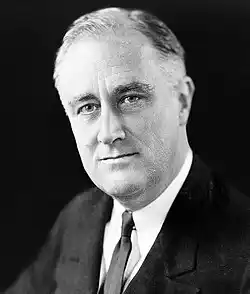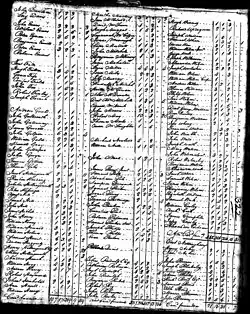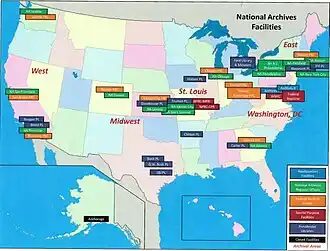The US National Archives or United States National Archives and Records Administration is a major branch of the US federal government which is tasked with preserving and managing historical, administrative and governmental records produced in the United States of America. The Archives and Records Administration dates back to 1934 when it was established in response to the ever growing amount of paperwork produced by the federal government and the need to manage this more efficiently. The National Archives are headquartered in Washington D.C. However, it has regional centers across the country in major cities like New York, Boston, Atlanta, Chicago, Kansas City, Denver, Seattle and San Francisco. The Archives contain an immense amount of material for the study of US government, politics and history. They are also the custodians of the foremost demographic and genealogical records produced in American history, notably the federal censuses that are held every ten years in the US. The Archives and Records Administration has digitized a huge amount of material in recent decades and much can now be consulted from a computer anywhere in the world.[1]
Research your ancestors on MyHeritage
US National Archives chronology of eventsUS National Archives chronology of events

All governments produce records and since medieval times there has been an awareness that many such records are worth preserving for future reference. When governments started doing this back in the Middle Ages they usually retained records of land transactions, royal decrees or legal rulings, things which they might need to consult again later to establish land titles or to check precedents in law. Between the fifteenth and seventeenth centuries more and more governments in Europe began retaining copies of the correspondence of rulers and government ministers. By the time the United States of American came into being in 1776 during the American Revolutionary War the range of records preserved by governments was expanding again as nation states began taking censuses of their people and the bureaucratic state expanded. This meant that from its very inception the US federal government was producing lots of paper records which were deemed to be worth keeping.[2]
Initially individual government ministers and their staff were left in charge of their preserving the records they accumulated. These were often passed on from staff to staff within a department or simply left in storage rooms in federal offices in Washington D.C. As new federal departments appeared in the nineteenth century and government became more structured, each department established filing and record-keeping systems for their ever expanding amount of paperwork. Eventually, though, the amount of records which individual departments were the conservators of had grown to such a huge volume that it was determined in the early 1930s that a federal agency would need to be established to manage all of the nation's official records.[3] In 1934 Congress passed legislation for the foundation of the US National Archives and Records Administration and President Franklin Delano Roosevelt passed the bill into law. Over the next several years the agency surveyed and gathered together an immense amount of federal records. Today it stores these in over 40 facilities across the nation, while also managing the presidential library system.[4]
Extent of collectionsExtent of collections

The size of the collections and the array of documents held and managed by the US National Archives and Records Administration is truly enormous, stretching to billions of records in total in a wide range of media. They are responsible for preserving all official documentation produced by the federal government. Therefore any official memoranda, bills, correspondence or working papers drawn up by Congress, the President and his staff, the many branches of the federal government, or any other political agencies, are deposited with the National Archives and stored by them. There is a legal onus on all of those involved in the federal government to deposit any documentation produced in line with their official duties with the Records Administration. All of this is done with an eye to preserving the history of the government and why decisions were made the way they were.[5] Furthermore, since it was first founded in 1934, the Archives and Records Administration has expanded form primarily preserving printed documents to also acting as custodian of digital records, film and other types of records.[6]
Beyond the operations of the executive and Congress, the Records Administration are also responsible for managing an array of other documents which are of great use for genealogists and family historians. For instance, the Archives and Records Administration is in charge of preserving the records of the US federal censuses, held every ten years in the United States since 1790. They manage a range of other material which is of using to the genealogist. These include immigration records, military service records, naturalization records, municipal records and a range of legal documentation which can shed further light on an ancestor’s life story.[7] Many people investigating their family history will also wish to consult their military military pertaining to the US Navy, Army, Marine Corps, Air Force and Coast Guard.[8]
Genealogical studies at the US National ArchivesGenealogical studies at the US National Archives

The material held by the National Archives can be consulted in a wide variety of ways for those wishing to carry out genealogical studies or to research their family history. Their website offers a range of searchable resources online. There are extensive finding aids thereon.[9] For those who wish to consult more obscure material which has not been digitized, the Archives and Records Administration have centers around the country in the nation’s largest cities, including New York, Boston, Philadelphia, Atlanta, Chicago, Kansas City, Dayton, Denver, Seattle and San Francisco, as well as managing the presidential libraries in various parts of the country.[10] Many of the foremost demographic and genealogical records held and preserved by the National Archives and Records Administration can be consulted through MyHeritage’s record collections. This includes searchable databases of the US Federal Censuses dating back to the first census in 1790.
See alsoSee also
Explore more about the US National ArchivesExplore more about the US National Archives
- Research Our Records at The US National Archives
- US Public Records Index records collection on MyHeritage
- United States Obituary Index records collection on MyHeritage
- 1790 United States Federal Census records collection on MyHeritage
- 1850 United States Federal Census records collection on MyHeritage
- 1900 United States Federal Census records collection on MyHeritage
- 1950 United States Federal Census records collection on MyHeritage
- The Coded Census: Deciphering US Censuses at Legacy Family Tree Webinars
- More Than Just Names: Advanced US Census Research at Legacy Family Tree Webinars
- Secrets of the US Federal Census at Legacy Family Tree Webinars
- Finding Ancestors in the United States between 1780 and 1840 at Legacy Family Tree Webinars
References
- ↑ https://www.archives.gov/
- ↑ Elizabeth Yale, ‘The History of Archives: The State of the Discipline’, in Book History, Vol. 18 (2015), pp. 332–359.
- ↑ Philip C. Brooks, ‘The Historian's Stake in Federal Records’, in The Mississippi Valley Historical Review, Vol. 43, No. 2 (September, 1956), pp. 259–274.
- ↑ R. D. W. Connor, ‘The National Archives of the United States’, in The Military Engineer, Vol. 31, No. 175 (1939), pp. 31–35.
- ↑ https://www.archives.gov/records-mgmt/public
- ↑ https://www.archives.gov/preservation/formats
- ↑ https://www.archives.gov/research/genealogy
- ↑ https://www.archives.gov/research/military
- ↑ https://www.archives.gov/publications/finding-aids/guides.html
- ↑ https://www.archives.gov/locations

